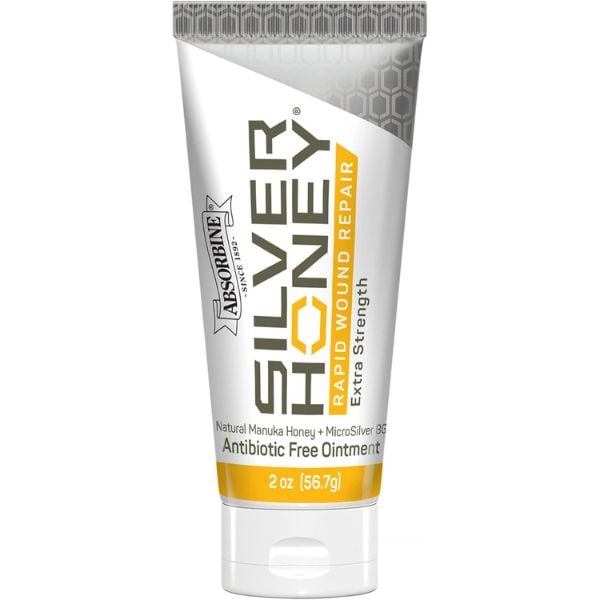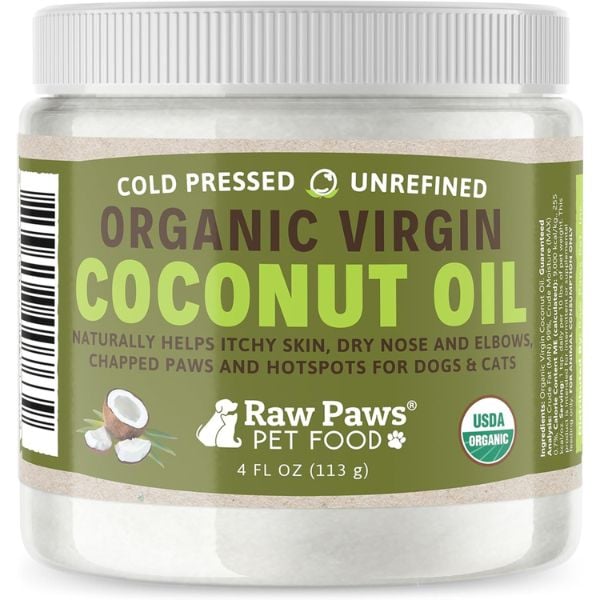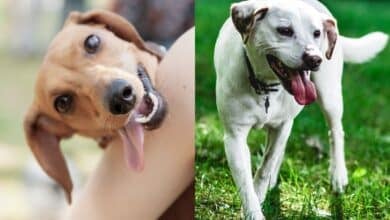10 Alternatives To Neosporin For Dogs: Holistic Home Remedies & Pet-Safe OTC Products
When you purchase through links on our site, we may earn a commission. Here’s how it works.
Your dog cuts his paw on a rock when you’re out for a walk. Instinctively, you reach for that familiar yellow tube of Neosporin in your medicine cabinet. After all, it’s what you’d use on yourself. But before you dab it on your dog’s skin, it’s worth pausing.
Table of Contents
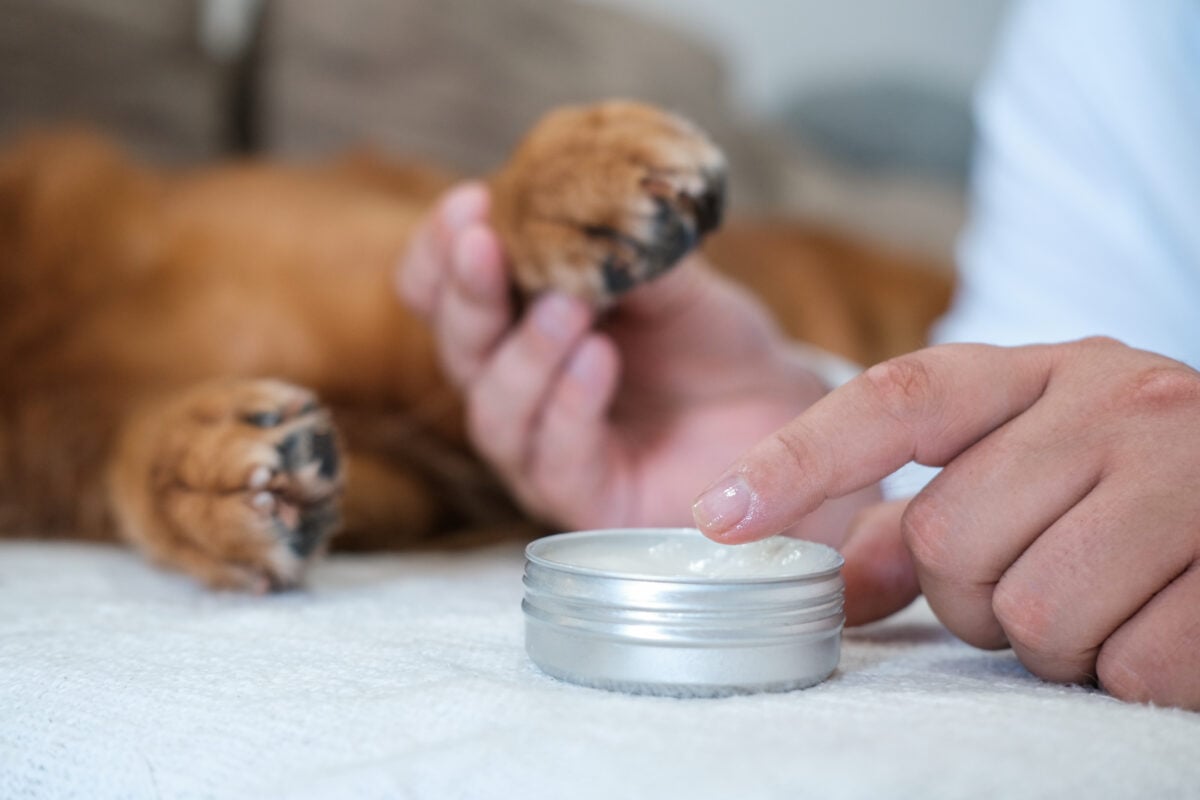
While Neosporin helps protect minor cuts and scrapes in humans, it’s not always the safest choice for pets. Dogs have different sensitivities, and their habit of licking wounds can turn a simple first aid fix into a bigger problem.
So what’s safe to use instead? Below, we’ll break down when (and if) Neosporin can be used on dogs, the risks to watch for, and vet-approved alternatives you can keep in your dog’s first-aid kit, including some gentle, pet-safe products available online.
What Exactly Is Neosporin & What Is It Used For?
Neosporin is one of the most common over-the-counter (OTC) ointments used for minor wounds, cuts, and abrasions in people. It’s a triple antibiotic blend containing:
- Bacitracin
- Neomycin
- Polymyxin B
Together, these three antibiotics help kill bacteria and prevent infection when applied to small, clean wounds. The ointment also acts as a protective barrier to keep dirt and germs out while the skin heals.
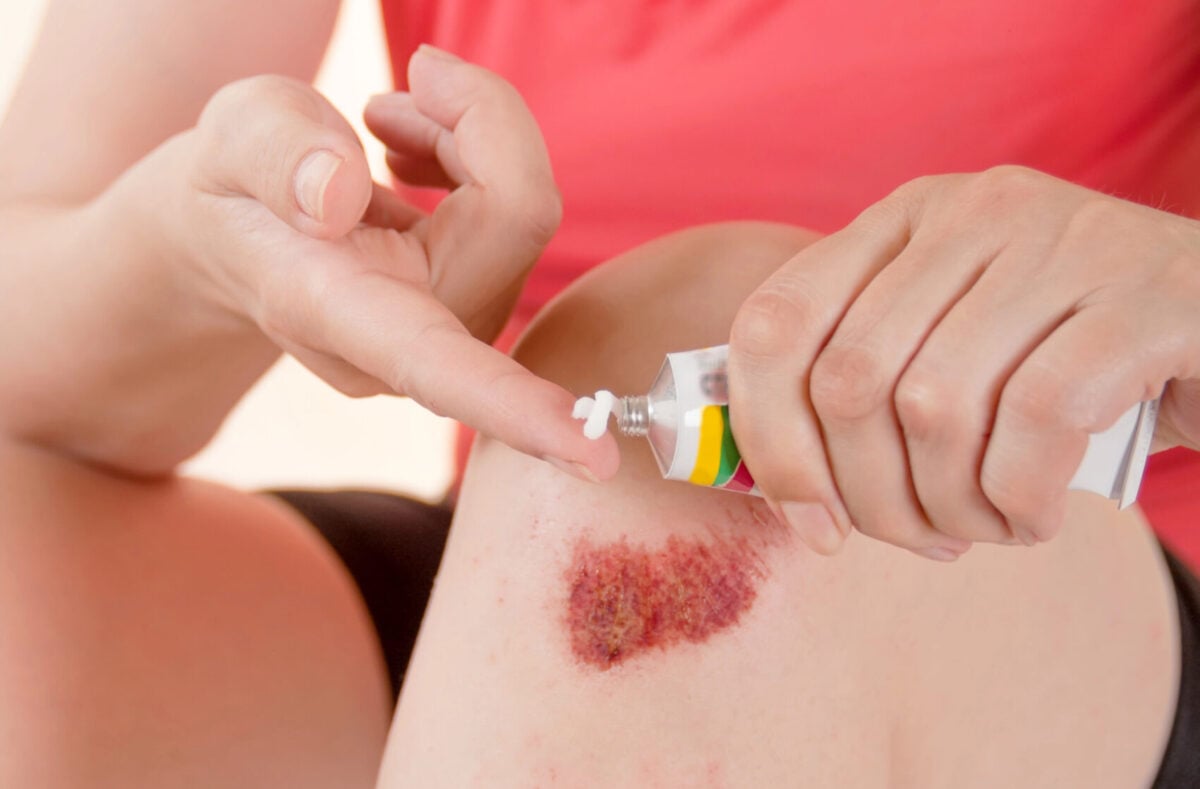
You’ll also find generic versions labeled as “triple antibiotic ointment.” These work similarly, and many dog owners assume that if it’s safe for us, it must be fine for our pets. Unfortunately, that’s not always true.
Can You Use Neosporin On Dogs?
Here’s the short answer: Sometimes, but only with your veterinarian’s approval.
Most vets agree that a thin layer of Neosporin can be safe for minor wounds if your dog can’t lick it off. That means minor scrapes or abrasions on areas out of reach (like the top of the head or back) may be fine temporarily.
However, Neosporin should never be used near your dog’s eyes, nose, mouth, or genitals, and it’s not recommended for deep, puncture, or infected wounds.
The biggest risk? Licking and ingestion.

Dogs naturally lick their wounds or any sore spot, and if they ingest enough Neosporin, it can lead to vomiting, diarrhea, drooling, or appetite loss. Some pups also experience allergic skin reactions — redness, itching, or swelling at the application site.
Because of these risks, many veterinarians now prefer pet-specific wound care products that work the same way without the dangerous side effects (we’ll share several options below).
Important Note for Cat Owners:
Neosporin is not safe for cats. Ingredients like neomycin and polymyxin B have caused severe allergic and anaphylactic reactions in cats, especially in eye or ear preparations. Always choose cat-specific wound care instead.
Understanding The Risks Of Neosporin For Dogs
It’s easy to assume Neosporin is harmless. After all, it’s sold over the counter and used on kids every day. But dogs process medications differently than humans do, and what’s safe for our skin can cause unintended problems for theirs.
Here’s what every pet parent should know before applying that ointment:
1. Allergic Reactions
Some dogs are hypersensitive to one or more of Neosporin’s ingredients. You might notice:
- Redness, swelling, or itching around the application site
- Excessive licking or rubbing at the area
- Hives or small bumps appearing after use
If any of these signs appear, wash the area immediately with mild soap and water and contact your vet. Continued exposure can worsen irritation and delay healing.
2. Ingestion & Digestive Upset
Dogs are expert self-groomers, which means anything you apply to their skin is likely to be licked off. Even small ingestions of Neosporin can cause vomiting, diarrhea, or loss of appetite.
Vet Tip:
If your pup insists on licking a wound, use an Elizabethan collar or inflatable recovery cone to protect the area until it heals.

3. Toxic Ingredients In “Plus Pain Relief” Formulas
Many human Neosporin products include extra ingredients like lidocaine or pramoxine for pain relief. These numbing agents can be toxic to pets, potentially causing weakness, tremors, or seizures if swallowed. Always double-check the label and avoid any Neosporin with “pain relief” on the packaging.
We have guides on the best pain meds and the best natural pain relief for dogs, including herbal options and more home remedies.
4. Possible Delayed Healing
While Neosporin can protect human skin, some studies suggest it may slow wound healing. In 2021, Drug Discovery News reported that overuse of topical antibiotics can disrupt normal skin flora, making it harder for tissue to regenerate.
The study by Johns Hopkins University researchers also found that humans with small skin wounds healed faster when using Vaseline than those who used Neosporin..
5. Neomycin Sensitivity & Organ Toxicity
Neomycin, one of Neosporin’s main ingredients, belongs to the aminoglycoside antibiotic family — a group known to cause hearing loss (ototoxicity) and kidney damage in dogs and cats when absorbed in higher doses.
While a tiny amount on the skin is unlikely to cause systemic toxicity, vets caution that open wounds increase absorption risk. It’s another reason many recommend switching to dog-safe alternatives instead.
When Can I Do At-Home Wound Care For Dogs?
When your dog gets a small cut, scrape, or irritated patch of skin, it’s natural to want to handle it yourself. The good news? Many minor wounds can safely be treated at home as long as you know what’s within first-aid territory and what needs professional attention.

Before reaching for anything in your medicine cabinet, pause to assess the injury. You can often manage these types of wounds on your own:
- Surface scrapes and scratches from rough play or brush contact
- Minor punctures or small cuts that are clean and not actively bleeding
- Mild skin irritations, rashes, or hot spots without open sores
- Post-grooming nicks, insect bites, or stings that just need protection from harmful bacteria
When Home Care Isn’t Enough
You can handle most superficial wounds at home, but anything deeper or infected requires veterinary care. Skip the DIY route and call your vet if:
- The wound is deep, bleeding heavily, or oozing pus
- Your dog keeps licking, chewing, or reopening the area
- The injury is near the eyes, mouth, joints, or genitals
- You suspect a bite, burn, or puncture that could trap bacteria beneath the skin
Vet Reminder:
Even small punctures can harbor infection under the surface, especially from another animal bite. When in doubt, let a vet examine it.
What’s A Safe Wound Care Alternative To Neosporin For Dogs?
So, what should you use instead of Neosporin when your dog gets a scrape or irritation? The best options are formulated specifically for pets, meaning they’re safe to lick (in small amounts), gentle on the skin, and free of ingredients that could harm your pup.

There are three main categories: vet-recommended prescription options, over-the-counter (OTC) products you can safely keep in your dog’s home first-aid kit, and holistic home remedies.
4 Over-The-Counter Pet-Safe Options
You don’t always need a prescription to treat minor cuts, scrapes, or hot spots. These ready-to-use wound care products for dogs are designed to fight bacteria and soothe irritation without the risks of human antibiotics or steroids.
1. Vetericyn Plus Antimicrobial Wound Care
View on Amazon | View on Chewy
Vetericyn is a veterinarian-trusted brand and a staple in many pet first-aid kits. The hypochlorous acid formula gently kills bacteria, fungi, and viruses while being completely safe if licked. It’s designed to help relieve itchy, irritated skin and help prevent infection by cleaning, flushing, and moisturizing cuts, abrasions, sores, and skin irritations.
Price
- Starts at $15.99 (3-oz bottle)
2. Sulfodene 3-Way Ointment for Dogs
View on Amazon | View on Chewy
This affordable, multipurpose ointment helps treat minor cuts, scrapes, and skin irritations. It combines antiseptic, pain-relieving, and soothing ingredients, such as benzocaine and salicylic acid, to prevent infection and promote comfort.
Price
- $9.29 (2-oz tube)
3. Absorbine Silver Honey Rapid Wound Repair
View on Amazon | View on Chewy
Made with medical-grade silver (MicroSilver BG), Manuka honey, shea butter, and calendula extract, this formula supports natural healing while keeping bacteria at bay. It’s non-toxic, sting-free, and ideal for dogs prone to licking. While it’s marketed for horses, many pup owners say it’s highly effective on their dogs and themselves.
Price
- $24.09 (2-oz tube)
4. Douxo S3 Pyo Wipes
View on Amazon | View on Chewy
Vet-recommended Douxo S3 PYO Chlorhexidine pads are antiseptic wipes designed for dogs with skin infections or chronic irritation. They help remove bacteria and yeast buildup while restoring the skin barrier. So, they’re great for wound cleaning and also for dogs prone to recurring skin issues.
Price
- $18.99 (30 wipes)
6 All-Natural, Holistic Alternatives To Neosporin For Dogs
If you prefer to skip medicated products altogether, there are gentle, all-natural wound care remedies that can help protect and soothe your pup’s skin.
These options can’t replace prescription medications for deep or infected wounds, but for minor cuts, scrapes, or irritations, they often do the trick safely, and many are vet-endorsed for their antibacterial or healing properties.
1. Manuka Honey
Few natural ingredients are as effective at wound healing as medical-grade Manuka honey. Produced in New Zealand, Manuka honey contains high levels of methylglyoxal (MGO), a compound with antibacterial and anti-inflammatory effects.
It helps kill bacteria, reduce inflammation, and speed up healing. It also forms a natural barrier to keep the wound clean and moist.
2. Aloe Vera Gel
Pure aloe vera gel (without alcohol or additives) provides soothing, anti-inflammatory relief for irritated skin. Aloe vera contains enzymes and growth factors that stimulate collagen production, which is essential for wound repair. It also helps cool hot spots and reduce redness.
We recommend Seven Minerals Organic Aloe Vera Gel, which contains 100% freshly-cut pure aloe that’s grown in Texas. Important note: Avoid aloe products that list “lidocaine” or “benzocaine,” which can be toxic if licked.
3. Coconut Oil
Coconut oil has mild antibacterial, antifungal, and moisturizing properties. It’s safe if ingested in small amounts and can help dry, flaky, or irritated skin heal faster. Choose cold-pressed, unrefined coconut oil for maximum purity and effectiveness, like Raw Paws Virgin Organic Coconut Oil for Dogs & Cats.
4. Plantain (Plantago major)
This humble green plant is known for its natural antibacterial and anti-itch qualities. Crushed leaves or plantain-based salves can be applied to minor bug bites, rashes, or surface wounds. It’s best used fresh from your garden or in organic salve form.
5. Yarrow
Used in herbal medicine for centuries, yarrow helps stop bleeding and acts as a mild antiseptic. When applied as a cooled tea or tincture, it may reduce inflammation and speed scab formation. However, Yarrow can be toxic if ingested, so you’ll have to use a cone with this option.
6. Calendula (Calendula officinalis)
Calendula is a favorite in natural veterinary medicine for its anti-inflammatory and skin-regenerating properties. It can be found in sprays, creams, or tinctures made specifically for pets. It’s a great natural choice for scrapes, mild rashes, or post-suture care.
Pro Tip:
Even natural products can cause allergic reactions. Always do a patch test before a full application.
Our Wellness Expert Weighs In
If you’re looking for a natural alternative that functions most like Neosporin, I recommend a pet-formulated colloidal silver gel. Colloidal silver has antimicrobial properties and can help protect minor wounds from infection.
Neem oil is another excellent option thanks to its antifungal and antibacterial benefits. It’s also soothing to irritated skin.
For healing and calming inflamed areas, manuka honey is a powerhouse. It’s known for its antibacterial and anti-inflammatory effects and can be used on burns, sores, and minor cuts.
If the primary concern is skin irritation — such as hot spots, insect bites, or mild burns — I usually recommend a dog-safe aloe vera gel or calendula cream for gentle relief.
– Tara Maurer, Wellness Expert & Writer For Canine Journal
Veterinarian-Recommended Prescription Options
If your vet determines your dog needs topical antibiotics, they’ll likely prescribe a pet-safe antibiotic ointment for dogs:
- Mupirocin topical: Mupirocin, also known as pseudomonic acid A (brand names Muricin, Bactroban, Centany), is an antibiotic used to treat skin infections.
- Silver sulfadiazine cream: A veterinary staple that helps prevent infection and promotes healing in burns and minor wounds. Often used after surgery or skin trauma.
- Bacitracin ointment: Unlike triple-antibiotic blends, plain bacitracin is sometimes prescribed for localized infections and tends to be gentler on sensitive dogs.
- Neomycin sulfate ointment: Occasionally used under vet supervision for bacterial skin infections, but should always be applied in limited quantities.
Always consult your vet before using any antibiotic ointment, even those deemed pet-safe. They can check whether your dog’s wound type or any underlying condition, like allergies or pyoderma, requires something stronger.
Supplies Needed For Dog Wound Care
You never expect your dog to get hurt — until it happens. Whether it’s a scraped paw from the park or a bug bite gone wrong, being prepared can make the difference between calm care and panic.
A well-stocked dog first-aid kit ensures you can respond quickly and safely. You might already have a few basics in your medicine cabinet, but some items should be pet-specific to avoid toxic ingredients or unsafe materials.
Here’s what every dog parent should have ready at home (and ideally, in your car, too):

A Quick First-Aid Checklist For Pet Parents
Keep a few essentials in your dog’s emergency kit so you can respond fast when accidents happen:
- Sterile gauze pads or self-adhesive bandages
Choose flexible, non-stick materials designed for pets (human bandages often pull fur or restrict movement). - Saline solution or wound rinse
For cleaning debris and bacteria from minor cuts or hot spots. - Pet-safe antiseptic spray or wipes
Look for chlorhexidine-based solutions - Tweezers or small forceps
For removing splinters, glass shards, or ticks. - Scissors
Rounded tips are safest for trimming fur around wounds or cutting bandages. - Clean towels or bandannas
Handy for wrapping, applying pressure, or creating a quick sling. - Disposable gloves
Protect both you and your pet during wound cleaning. - Instant cold pack
Helps reduce swelling or bruising after bumps or bites. - Muzzle or soft cone
Even the gentlest dog can nip when scared or in pain.
Pro Tip:
Store your dog’s first-aid supplies separately from human ones. That way, you’ll never grab the wrong tube in a hurry.
Next, let’s walk through step-by-step wound care tips — how to clean, treat, and protect your dog’s skin safely to prevent infection and help them heal faster.
Step-By-Step Wound Care For Dogs
Even the best ointment won’t help if the wound isn’t cleaned and appropriately protected. Whether you’re treating a scrape at home or managing a minor cut between vet visits, good wound care technique makes all the difference.
Here’s how to safely treat your dog’s injury from start to finish.
Step 1: Clean The Wound Gently
Rinse the area with lukewarm water or sterile saline to remove dirt, grass, or debris. Avoid using hydrogen peroxide or rubbing alcohol, which can sting and damage healthy tissue, slowing the healing process. If the fur around the wound is long, carefully trim it so the area stays clean and dry.
Vet Tip:
A mild, diluted chlorhexidine solution can be used for gentle disinfecting — just make sure it’s formulated for animals.
Step 2: Inspect The Injury
Look closely for punctures, swelling, or discharge. If you spot pus, heat, or redness spreading outward, the wound could be infected and needs veterinary attention. For clean, shallow scrapes or small cuts, continue with at-home care.
Step 3: Dry The Area Thoroughly
Use a clean gauze pad or towel to pat the wound completely dry. A damp environment can trap bacteria, so never apply ointment or spray to wet skin.
Step 4: Apply A Pet-Safe Ointment Or Spray
Once clean and dry, apply a thin layer of a dog-safe antimicrobial spray, hydrogel, ointment, or an all-natural solution we’ve recommended above.

Step 5: Keep Your Dog From Licking
Licking introduces bacteria and can reopen healing wounds. Use an Elizabethan collar (cone), inflatable recovery collar, or a light wrap if needed. If your dog’s wound is in a tricky spot, your vet can recommend safe bandaging techniques or prescribe anti-itch sprays to discourage licking.
Step 6: Monitor The Healing
Check the wound daily. Watch for:
- Redness or swelling that worsens
- A foul odor or yellow/green discharge
- Excessive heat or tenderness
- Your dog is acting lethargic or seems to be in pain
If any of these occur, contact your vet right away. Early infection treatment prevents complications and speeds recovery.
Should I Consider Pet Insurance?
Even minor injuries can become unexpectedly expensive if an infection develops or stitches are needed. A simple wound check can turn into hundreds or even thousands of dollars in emergency care if your dog requires sedation, antibiotics, or follow-up visits.

That’s why many dog parents invest in pet insurance — to reduce out-of-pocket costs when accidents and unforeseen illnesses happen. If your dog cuts a paw on a hike or gets a hot spot that needs vet treatment, a good pet insurance policy can help cover:
- Emergency treatment and wound cleaning
- Prescription antibiotics or pain relief (medication coverage may require a plan upgrade)
- Surgery or hospitalization for severe injuries
See our in-depth guide to the best pet insurance companies to compare plans that fit your dog’s needs and your budget.
Frequently Asked Questions
Have a question we didn’t answer? Drop it in the comments below! Our team (and fellow readers) love helping other dog parents troubleshoot minor injuries safely.
Can I Use Hydrogen Peroxide Or Alcohol To Clean My Dog’s Wound?
Avoid both. Although they kill bacteria, they also damage healthy tissue and delay healing. Vets recommend rinsing wounds with lukewarm water or sterile saline instead, followed by a pet-safe antiseptic spray if needed.
What Should I Do If My Dog Keeps Licking The Wound?
Persistent licking can undo healing and invite infection. Use an Elizabethan collar (cone) or an inflatable recovery collar to block access. For restless dogs, ask your vet about anti-itch sprays or mild topical deterrents made for pets.
What’s The Best Way To Prevent Wound Infections In Dogs?
The best prevention is quick, gentle cleaning and daily monitoring. Keep the area dry, apply a pet-safe antimicrobial product, and make sure your dog’s nails and bedding stay clean during recovery. Regular grooming also helps you catch new skin issues early.
Is Neosporin Good For Dogs?
Neosporin can be safe in small, limited amounts, but it’s not ideal for routine dog wound care.
Because dogs tend to lick their wounds, even small doses can cause digestive upset or allergic reactions.
Some formulations also contain pain-relief ingredients (like lidocaine) that are toxic to pets. If you want a safer alternative, use Vetericyn Plus or Silver Honey, both of which are vet-approved, non-toxic, and safe if licked.
Can Neosporin Kill A Dog?
In most cases, a small lick of Neosporin won’t be fatal, but repeated ingestion or use of “extra strength” or “pain-relieving” versions can cause serious side effects, including vomiting, tremors, or even organ toxicity if consumed in larger quantities.
Dogs with allergies to neomycin or polymyxin B are especially at risk for severe reactions. To be safe, skip the human ointments and reach for a dog-formulated wound care product instead.
How Long Does It Take For A Dog’s Cut To Heal?
It depends on the wound size and depth. Minor scrapes or abrasions often heal within 3–7 days, while deeper cuts can take two weeks or longer. Proper cleaning, daily monitoring, and preventing licking are key to faster healing. If redness, swelling, or drainage increases, contact your vet.
Caring For Your Dog’s Skin
Making sure you keep your dog’s skin as healthy as possible can promote better wound healing if they get injured. Start with a high-quality, all-natural diet. If your pup’s skin is dry, sensitive, or itchy, use a dog shampoo for sensitive skin. You may also want to consult your vet about giving them a fish oil supplement to improve skin and coat health.
Have you ever used a pet-safe wound ointment or spray that worked wonders for your dog? Share your experience in our comments below. Your story could help another pet parent facing the same situation.


